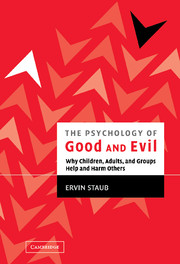Book contents
- Frontmatter
- Contents
- Preface
- Acknowledgments
- PART I INTRODUCTION AND CORE CONCEPTS
- PART II THE ROOTS OF HELPING OTHER PEOPLE IN NEED IN CONTRAST TO PASSIVITY
- PART III HOW CHILDREN BECOME CARING AND HELPFUL RATHER THAN HOSTILE AND AGGRESSIVE
- PART IV THE ORIGINS OF GENOCIDE, MASS KILLING, AND OTHER COLLECTIVE VIOLENCE
- 21 A Note on the Cultural–Societal Roots of Violence
- 22 The Psychology of Bystanders, Perpetrators, and Heroic Helpers
- 23 Steps Along a Continuum of Destruction: Perpetrators and Bystanders
- 24 The SS and the Psychology of Perpetrators: The Interweaving and Merging of Role and Person
- 25 The Origins of Genocide: Rwanda
- 26 Bystanders as Evil: The Example of Rwanda
- 27 Individual and Group Identities in Genocide and Mass Killing
- 28 Mass Murder: U.S. Involvement as Perpetrator, Passive Bystander, Helper
- 29 When Instigation Does Not Result in Mass Murder
- 30 Persian Gulf Conflict Was Reflection of Stormy Undercurrents in U.S. Psyche
- 31 Mob Violence: Cultural–Societal Sources, Instigators, Group Processes, and Participants
- 32 Understanding and Preventing Police Violence
- PART V THE AFTERMATH OF MASS VIOLENCE: TRAUMA, HEALING, PREVENTION, AND RECONCILIATION
- PART VI CREATING CARING, MORALLY INCLUSIVE, PEACEFUL SOCIETIES
- Appendix: What Are Your Values and Goals?
- Index
- References
28 - Mass Murder: U.S. Involvement as Perpetrator, Passive Bystander, Helper
Published online by Cambridge University Press: 07 May 2010
- Frontmatter
- Contents
- Preface
- Acknowledgments
- PART I INTRODUCTION AND CORE CONCEPTS
- PART II THE ROOTS OF HELPING OTHER PEOPLE IN NEED IN CONTRAST TO PASSIVITY
- PART III HOW CHILDREN BECOME CARING AND HELPFUL RATHER THAN HOSTILE AND AGGRESSIVE
- PART IV THE ORIGINS OF GENOCIDE, MASS KILLING, AND OTHER COLLECTIVE VIOLENCE
- 21 A Note on the Cultural–Societal Roots of Violence
- 22 The Psychology of Bystanders, Perpetrators, and Heroic Helpers
- 23 Steps Along a Continuum of Destruction: Perpetrators and Bystanders
- 24 The SS and the Psychology of Perpetrators: The Interweaving and Merging of Role and Person
- 25 The Origins of Genocide: Rwanda
- 26 Bystanders as Evil: The Example of Rwanda
- 27 Individual and Group Identities in Genocide and Mass Killing
- 28 Mass Murder: U.S. Involvement as Perpetrator, Passive Bystander, Helper
- 29 When Instigation Does Not Result in Mass Murder
- 30 Persian Gulf Conflict Was Reflection of Stormy Undercurrents in U.S. Psyche
- 31 Mob Violence: Cultural–Societal Sources, Instigators, Group Processes, and Participants
- 32 Understanding and Preventing Police Violence
- PART V THE AFTERMATH OF MASS VIOLENCE: TRAUMA, HEALING, PREVENTION, AND RECONCILIATION
- PART VI CREATING CARING, MORALLY INCLUSIVE, PEACEFUL SOCIETIES
- Appendix: What Are Your Values and Goals?
- Index
- References
Summary
This chapter examines the involvement of the United States in mass murder: as perpetrator, as indirect actor involved in creating conditions contributing to mass murder, as well as a bystander that supported perpetrators, remained passive, or actively attempted to halt mass murder.
the united states as perpetrator: mass killing of native americans
Native Americans, profoundly different in appearance and ways of life from the whites arriving from Europe, were seen as primitive, uncivilized, with no culture. Over time, they came to be also seen as violent and dangerous. Devaluation, fear and self-interest, wanting the land on which Native Americans lived, all affected policies toward them. There was an evolution of increasing harm-doing that led to mass murder.
At first, Native Americans were to be civilized, presumably to lessen their difference from other Americans and to enable them to function in America. Trade, religious missions and conversion, white schooling for the children were all to serve these purposes (Sheehan, 1973). These “civilizing” acts were seen as altruistic. Native Americans were changing in response, but not to a sufficient degree. They continued to live tribal lives and occupy huge areas of land. The policy was changed to relocate Native Americans to the West. This would both remove them from the vicinity of other Americans and provide land. Many tribes resisted relocation, which was to be enforced by the U.S. Army. There were many battles, especially after 1829, when Andrew Jackson became president. Some tribes fought until few remained alive.
- Type
- Chapter
- Information
- The Psychology of Good and EvilWhy Children, Adults, and Groups Help and Harm Others, pp. 360 - 367Publisher: Cambridge University PressPrint publication year: 2003



